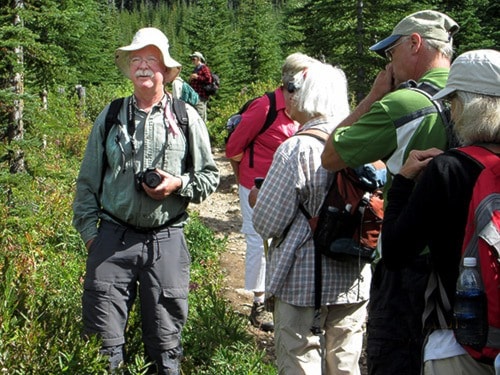Two of what many participants felt were the most interesting presentations so far in the Wells Gray World Heritage Year were made last weekend – and they had what some might consider the most unlikely of subject matter.
Thursday evening and Friday botanist Andy MacKinnon talked about alpine flowers.
And on Saturday evening and Sunday entomologist Rob Higgins talked about ants.
“The alpine is a challenging place for plants, but many of them do spectacularly well there,” MacKinnon said during a lecture presented Thursday evening at Upper Clearwater Hall.
Alpine plants must cope with low winter temperatures, a short and unpredictable growing season, strong winds, and high light intensity – especially ultra-violet light.
Plant species that do develop coping strategies for alpine conditions find large areas of western North America open to them. Many alpine species also grow in polar regions as well.
The elevation of treeline, which is where the alpine begins, drops lower as one moves towards the poles. The alpine is always lower near the coast than inland.
Tree-lines have been going up as a result of climate change. Trees are growing higher than they did before.
The area of alpine tundra is predicted to decrease by about 80 per cent in the next 50 to 75 years.
There has been a huge die-off of yellow cedar on the B.C. and Alaskan coast because of climate change. Warming temperatures have decreased the snowpack, which paradoxically has increased the likelihood of the trees' roots getting frozen in winter.
Many alpine plants grow close to the ground to avoid the cold and the wind.
Many are evergreens, so they don't need to grow new leaves during the short growing season.
Because the growing season is short and sometimes doesn't even happen, nearly all alpine plants are perennials.
Because red pigments absorb more heat than green, reddish foliage can be an adaptation to cold. It also might help with UV screening.
Almost all alpine plants have hairy leaves. The hairs lessen the effect of wind to cool and dry out, but still allow the leaves to exchange gases for survival.
Arctic poppy flowers turn to track the sun. This helps keep their ovaries up to six degrees C warmer than their surroundings.
“The alpine is a pretty cool area,” MacKinnon said.
About 20 people attended the lecture on alpine plants and roughly the same number took part in a hike to Trophy Mountain flower meadows the following day.
All about ants
Thompson Rivers University researcher Rob Higgins took a hands-on approach during a field trip to teach abut ants on Sunday morning.
About 20 people had attended a lecture he gave at Upper Clearwater Hall on the topic the evening before, but cool and wet weather reduced that number to about half for the field trip.
 The lecture had been fascinating although a little gruesome in parts, one participant said. Topics covered included decapitating ants and dracula ants.
The lecture had been fascinating although a little gruesome in parts, one participant said. Topics covered included decapitating ants and dracula ants.
Despite the unpromising weather, Higgins quickly uncovered several ants nests near the hall during the field trip.
Rolling over a log, he found a nest of a particular species of ant that starts its colony by parasitizing the colony of another species. The ants move in, kill the other queens, then trick the remaining workers to continue working as slaves to support them.
There is some justice in the world, however. A third species of ant sometimes parasitizes the second. Its queens move in and trick the workers of the colony to feed and care for them. They don't produce more workers, however, only more queens.
The ants we see moving around on the surface are less than one per cent of the colony's total number, Higgins said.
Research has shown the workers can live five or six years. They start off caring for eggs and larvae. They then graduate to maintaining the nest itself. Only during the last stage of their life to they forage outside the nest. That stage typically only lasts six days before they are killed.
The ants build their nest under and inside a log for a reason. The log typically stays warmer at night than the soil and so is used to incubate larvae.
Some species dispense with surface foraging altogether. They raise aphids underground plus eat insects that live in the soil.
Only their reproductive stages appear above ground.
European fire ants are becoming a problem in Canada.
In the United Kingdom, on the other hand, they are protected. A rare species of butterfly uses their nests to over-winter.
The next Wells Gray World Heritage Year event will be Volcanoes 101 with Cathie Hickson. There will be a lecture at Upper Clearwater Hall on Friday at 7 p.m., followed by field trips on Saturday and Sunday.
